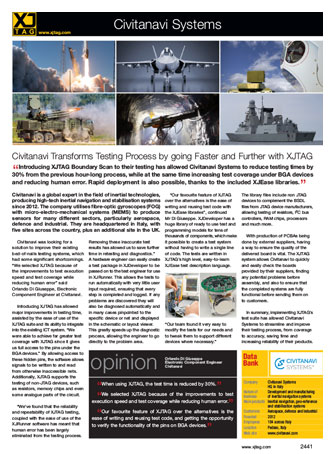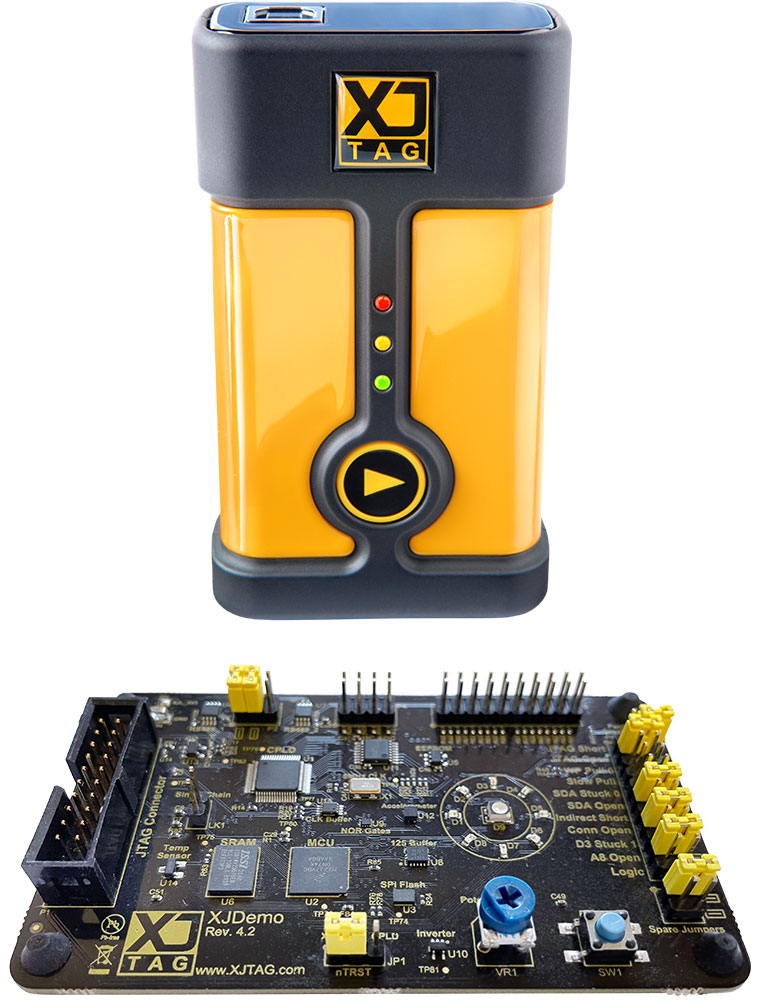
Civitanavi Transforms Testing Process by going Faster and Further with XJTAG
Introducing XJTAG Boundary Scan to their testing has allowed Civitanavi Systems to reduce testing times by 30% from the previous hour-long process, while at the same time increasing test coverage under BGA devices and reducing human error. Rapid deployment is also possible, thanks to the included XJEase libraries.
Civitanavi is a global expert in the field of inertial technologies, producing high-tech inertial navigation and stabilisation systems since 2012. The company utilises fibre-optic gyroscopes (FOG) with micro-electro-mechanical systems (MEMS) to produce sensors for many different sectors, particularly aerospace, defence and industrial. They are headquartered in Italy, with five sites across the country, plus an additional site in the UK.
Civitanavi was looking for a solution to improve their existing bed-of-nails testing systems, which had some significant shortcomings. “We selected XJTAG because of the improvements to test execution speed and test coverage while reducing human error” said Orlando Di Giuseppe, Electronic Component Engineer at Civitanavi.
Introducing XJTAG has allowed major improvements in testing time, assisted by the ease of use of the XJTAG suite and its ability to integrate into the existing ICT system. “We were able to achieve far greater test coverage with XJTAG since it gives us full access to the pins under the BGA devices.” By allowing access to these hidden pins, the software allows signals to be written to and read from otherwise inaccessible nets. Additionally, XJTAG supports the testing of non-JTAG devices, such as resistors, memory chips and even some analogue parts of the circuit.
“We’ve found that the reliability and repeatability of XJTAG testing, coupled with the ease of use of the XJRunner software has meant that human error has been largely eliminated from the testing process. Removing these inaccurate test results has allowed us to save further time in retesting and diagnostics.”
A hardware engineer can easily create a test package in XJDeveloper to be passed on to the test engineer for use in XJRunner. This allows the tests to run automatically with very little user input required, ensuring that every step is completed and logged. If any problems are discovered they will also be diagnosed automatically and in many cases pinpointed to the specific device or net and displayed in the schematic or layout viewer. This greatly speeds up the diagnostic process, allowing the engineer to go directly to the problem area.
“Our favourite feature of XJTAG over the alternatives is the ease of writing and reusing test code with the XJEase libraries”, continued Mr Di Giuseppe. XJDeveloper has a huge library of ready to use test and programming models for tens of thousands of components, which make it possible to create a test system without having to write a single line of code. The tests are written in XJTAG’s high level, easy-to-learn XJEase test description language. “Our team found it very easy to modify the tests for our needs and to tweak them to support different devices where necessary.” The library files include non JTAG devices to complement the BSDL files from JTAG device manufacturers, allowing testing of resistors, I2C bus controllers, RAM chips, processors and much more.
With production of PCBAs being done by external suppliers, having a way to ensure the quality of the delivered board is vital. The XJTAG system allows Civitanavi to quickly and easily check the boards provided by their suppliers, finding any potential problems before assembly, and also to ensure that the completed systems are fully functional before sending them on to customers.
In summary, implementing XJTAG’s test suite has allowed Civitanavi Systems to streamline and improve their testing process, from coverage to accuracy, saving time and increasing reliability of their products.

When using XJTAG, the test time is reduced by 30%.
We selected XJTAG because of the improvements to test execution speed and test coverage while reducing human error.
Our favourite feature of XJTAG over the alternatives is the ease of writing and reusing test code, and getting the opportunity to verify the functionality of the pins on BGA devices.

Company: Civitanavi Systems
Nature of business:
Development and manufacturing of inertial navigation systems
Main products:
Inertial navigation, geo-reference and stabilisation systems
Customers:
Aerospace, defence and industrial
Founded: 2012
Employees: 184 across Italy
Location: Pedaso, Italy
Web site: www.civitanavi.com















